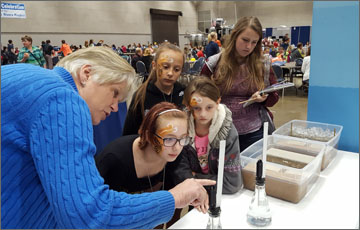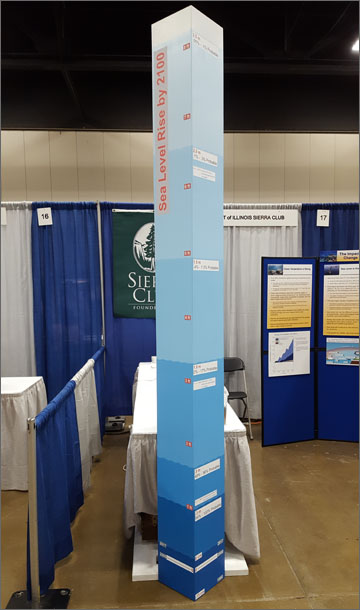May 2017

The HOI Group participated in the Clean Water Celebration with a display at the Peoria Civic Center on April 24th. Past topics for our display have included rain barrels, coal ash, and fracking. Our topic this year was The Impact of Climate Change on Water, which focused primarily on the oceans. Approximately 2,500 students, grades 4 through 12, teachers, and members of the public attended. We focused on three primary ways climate change is impacting the oceans.
Sea Level is Rising
Sea level has risen 21 centimeters (approximately 8.5 inches) since 1880. It has risen at a rate of .06 inches per year from 1880 to 2013, but since 1993 it has risen .11 to .14 inches per year. The lowest estimated sea level rise from year 2000 to 2100 is 0.3 meters (about 1 ft.) with a probability of 94% to 100%. The highest estimated sea level rise (worst case scenario) is 2.5 meters (about 8¼ ft.), with a probability of .05% to.1%. To display sea level rise in a way students could easily relate to, we built a tower to show the rise from 1880 to the present, and the probabilities of sea level rising to different levels by 2100. The sea level rise estimates for our display were taken from the recent report released by the National Oceanic and Atmospheric Administration (NOAA) on January 19, 2017.
The two major causes of global seal level rise are:
- Increased melting of land-based ice, such as glaciers and ice sheets, primarily in Antarctica and Greenland.
- The thermal expansion caused by warming of the ocean (since water expands as it warms), which is reponsible for 50% of sea level rise since 1993.
To show land-based ice melt's impact on sea level, our exhibit displayed two containers of water, one with ice not in the water (land ice), and one with ice in the water (sea ice). As the ice melted, students could see that the water level rose in the first container with land ice but did not rise in the second container with sea ice.
To show thermal expansion, we displayed two flasks with glass tubes and thermometers inserted through rubber stoppers. One flask was kept at room temperature and the other heated to a temperature approximately 20 degrees higher. The room temperature flask had no water in it's glass tube but in the heated flask the water rose into the glass tube.
Ocean Temperature is Rising
Over 90% of global warming is absorbed by the ocean. The ocean can store 1,000 times more heat than the atmosphere and acts like a buffer, preventing a much larger increase in atmospheric temperature. Average sea surface temperature has risen about 1.4° F since 1880, and is projected to rise another .9° F to 3° F by 2100.

Coral reefs will bleach (eject their symbiotic algae) at even a slight persistent temperature rise. Bleaching slows coral growth, makes them susceptible to disease, and can lead to large-scale reef die-off. More than two-thirds of the coral in Australia’s Great Barrier Reef is experiencing “shocking” amounts of bleaching. In just a few decades coral reefs and all their rich biodiversity could disappear completely.
Warmer surface water dissipates more readily into vapor, creating stronger and more frequent storms and hurricanes. Warmer sea temperatures are associated with the spread of invasive species and marine diseases. Warmer temperatures can impact ocean currents, which have a major impact on climate.
Ocean Acidity is Increasing
One third of carbon dioxide (CO2) emitted by humans is dissolved in the ocean. CO2 reacts with seawater to form carbonic acid, which makes the seawater more acidic. (a lower pH level). The pH level of the oceans has decreased by approximately 0.1 pH units (8.2 to 8.1) since pre-industrial times, equivalent to an approximately 30% increase in acidity. By the year 2100, the surface waters of the ocean could be nearly 150% more acidic than pre-industrial levels.
Increased acidification reduces the availability of calcium carbonate, a key building block for the shells and skeletons of many marine organisms such as corals and oysters. If CO2 concentrations continue to rise at their current rate, the combination of rising ocean temperature and ocean acidification could slow coral growth by nearly 50% by 2050. Increasing acidity is dissolving the shells of pteropods, a key species of pea-sized sea creature at the base of the food chain. When scientists placed a pteropod’s shell in sea water with pH and carbonate levels projected for the year 2100, the shell slowly dissolved after 45 days.
Click here for more pictures of our climate change display at this year's Clean Water Celebration.